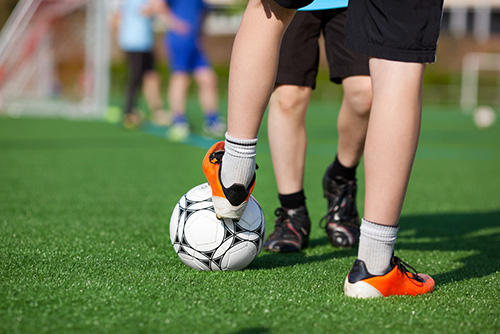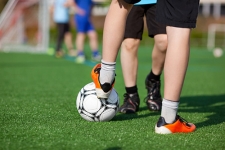Sever’s Disease – Sever’s disease is one of most common causes of heel pain in children. It often occurs during growth spurts and is an inflammatory condition of the growth plate in the heel bone. Running, jumping, and being active lead to repetitive stress on the growth plate as the foot strikes the ground. This results in inflammation in the growth plate, which causes heel pain.

Osgood-Schlatter Disease – Children with Osgood-Schlatter disease will experience pain at the front of the knee due to inflammation of the growth plate at the upper end of the tibia, or shinbone. This growth plate (tibial tubercle) is a bump near the top of the tibia where the tendon from the kneecap (patellar tendon) attaches to the bone. Increased activity causes the quadriceps muscles of the thigh to pull on the patellar tendon, which in turn pulls on the tibial tubercle. In some children, this repetitive traction or pulling on the tibial tubercle leads to inflammation, swelling, and tenderness. The prominence, or bump, of the tibial tubercle may become very pronounced. Painful symptoms are often brought on by running, jumping, and other sports-related activities.
Jumper’s Knee – Jumper’s knee refers to pain that occurs in the lower portion of the kneecap (patella). These painful symptoms can range from mild to severe. Repetitive contraction of the quadriceps muscles in the thigh can stress the patellar tendon in the spot where it attaches to the kneecap, causing inflammation and tissue damage. In growing children, the patellar tendon attaches to the growth plate of the kneecap, and repetitive stress on the tendon can irritate and injure the growth plate. This condition is referred to as Sinding-Larsen-Johansson disease. Jumper’s knee tends to be more prevalent in kids who are active in sports that involve jumping (like basketball and volleyball) but it can occur with virtually any athletic endeavor. Regardless if the problem stems from the tendon or growth plate, a child will need to rest from sports activities until the pain resolves.
The good news is that many overuse injuries in children can be prevented. The key to prevention is to avoid overdoing any single sport, and to allow your children’s growing bodies adequate rest between practices or games.
The American Academy of Orthopaedic Surgeons has partnered with STOP Sports Injuries to help educate parents, coaches, and athletes about how to prevent overuse injuries. Specific tips to prevent overuse injuries include:
* Limit the number of teams in which your child is playing on in one season. Kids who play on more than one team are especially at risk for overuse injuries.
* Do not allow your child to play one sport year round — taking regular breaks and playing other sports is essential to skill development and injury prevention.
Remember – when a young athlete repeatedly complains of pain, rest is paramount! And, if the pain continues, it’s incredibly important to seek treatment with one of the orthopaedic surgeons here at Prairie Orthopaedic…our specialists are well versed in the diagnosis and treatment of these types of injuries. To ensure the best possible recovery, athletes, coaches, and parents must follow safe guidelines for returning to the game.

